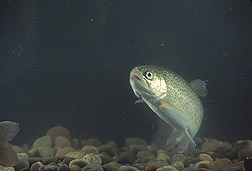This page has been archived and is being provided for reference purposes only. The page is no longer being updated, and therefore, links on the page may be invalid.
|
Progress Toward Larger Trout
By Sharon DurhamJuly 20, 2005
Bigger rainbow trout for consumers is the goal of Agricultural Research Service (ARS) scientists who are working with industry on genetic methods to more efficiently produce fish that grow faster.
William K. Hershberger, research leader at the ARS National Center for Cool and Cold Water Aquaculture in Kearneysville, W.Va., and his colleagues have developed a more effective way to produce rainbow trout that have three sets of chromosomes instead of the usual two sets.
Trout with three chromosome sets grew faster than fish with two sets, so the industry tries to breed fish with three sets for meat production. Rainbow trout with three sets of chromosomes grow faster because they are unable to reproduce. The energy from the food they eat is shifted from reproduction to growth.
One of the most reliable ways to produce fish with three sets of chromosomes is to cross fish that have four sets of chromosomes with typical fish that have two sets. Trout with four sets can be created by precise, high-pressure treatment of rainbow trout embryos during very early development. Hershberger and his group have succeeded in fine-tuning the treatment procedures to more reliably yield rainbow trout with four sets of chromosomes.
Meeting consumer demand for trout requires an increase in production. Marketable trout size has increased from one pound to almost two pounds and is continuing to increase, due to consumer desire for an 8- to 10-ounce fillet.
Production of sterile, three-chromosome-set fish ensures no genetic interaction with indigenous stocks, meaning these fish can be used to protect native germplasm. These characteristics can ensure environmental security and improve profit for the aquaculture industry.
ARS is the U.S. Department of Agriculture's chief in-house scientific research agency.

